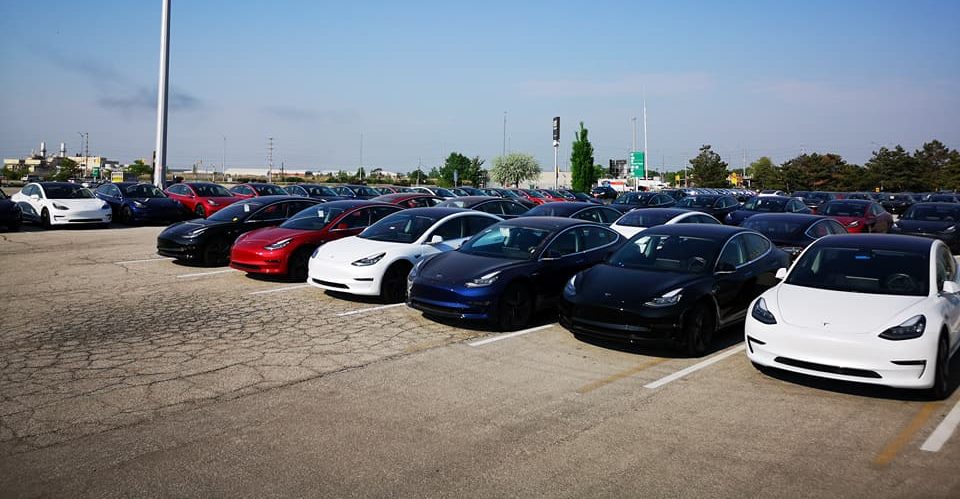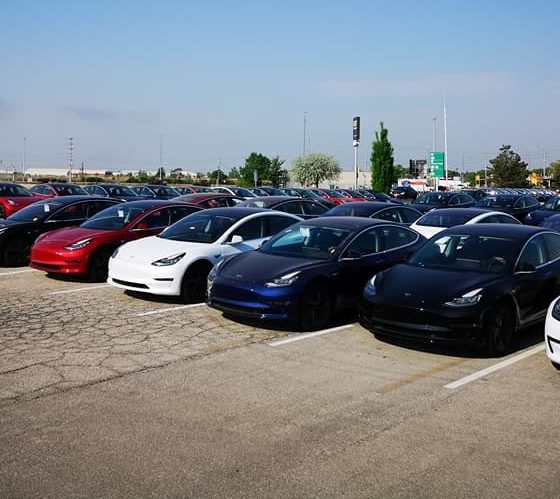

News
Tesla will be shipping 3k Model 3 to Europe every week by Feb 2019: report
Tesla’s global assault with the Model 3 is set to hit its stride next year, as the electric car maker starts rolling out the vehicle to territories beyond the United States and Canada. In Europe, Tesla has recently invited Model 3 reservation holders to configure their vehicles, with the company setting an estimated delivery date of February 2019 for orders of the Model 3 Performance and the Long Range AWD.
Reports have now emerged from local media that Tesla would be shipping 3,000 vehicles per week to Europe starting February 2019. Belgian news agency Focus-WTV, for one, stated that the electric cars would be arriving every week in the port of Zeebrugge, which is located on the coast of Belgium (special thanks to Tesla owner-enthusiast Hans Noordsij, who tipped Teslarati off about the Focus-WTV report). The local news outlet noted that the electric cars are shipped through the services of transportation firm International Car Operators (ICO), which operates a site on the Zeebrugge docks.
ICO’s operations are particularly notable as the company uses RoRo (roll-on, roll-off) ships, which are capable of loading and unloading cargo in a quick manner. The transportation of Tesla’s vehicles from the United States to Zeebrugge will reportedly take about 15 days, with the route going through the Panama Canal. Upon arriving at the coastal port, the electric cars would be distributed across Tesla’s delivery centers in Europe. ICO is reportedly investing 2.5 million euros ($2.83 million) to accommodate the influx of Tesla’s vehicles as well.
Elon Musk has noted that Tesla is now at a point where it is capable of producing 5,000 Model 3 per week without straining its facilities or its workforce. That said, reports have emerged stating that Tesla is already closing in on a pace equal to 1,000 Model 3 per day. This was mentioned by Pierre Ferragu of New Street Research, who noted that Tesla’s path towards higher production outputs seems to be clear. The Wall Street analyst even noted that Tesla is likely capable of hitting a pace equal to 7,000-10,000 Model 3 per week with limited CapEx.
“The road to 7,000 units per week seems easy, and limited capital expenditures will be required (in the low tens of millions) to get to 10,000. We don’t know for sure what demand will ultimately be, but we know that from here, Tesla will expand its price range, introduce leasing, and expand internationally. All these levers combined have a lot of depth and should be more than enough to get to 10,000 Model 3 per week at the end of next year,” Ferragu wrote.
With production of the Model 3 hitting sustainable levels, Tesla is now able to start preparing the vehicle for deliveries to foreign markets. Apart from Europe, Tesla has also opened the Model 3 configurator to reservation holders in China. The reception among Chinese electric car buyers has been notable so far, despite Tesla’s business in the country being weighed down by the 40% import tariffs placed on vehicles due to the US-China trade war. With recent reports stating that China will likely reduce import tariffs to just 15%, Tesla’s presence in the Chinese market would likely be even more notable in the coming quarters.
The Tesla Model 3 is a “bet-the-company” project, with Elon Musk putting the electric car maker’s future on the success of the electric sedan. Despite a trip through “production hell,” the Model 3 has been proving itself in the US market, ranking among the best-selling vehicles in the country over the past few months despite America’s preference for larger vehicles like SUVs and pickup trucks. In foreign territories, the Model 3 might actually have even more potential, with Tesla noting in its Q3 2018 Update Letter that the mid-sized premium sedan market in Europe is “more than twice as big as the same segment in the US.” With this in mind, the auto industry would likely soon come to terms with the notion that while the electric sedan is already making waves in the US and Canada, the Model 3’s real potential has not even been fully tapped yet.

Elon Musk
Elon Musk’s X will start using a Tesla-like software update strategy
The initiative seems designed to accelerate updates to the social media platform, while maintaining maximum transparency.

Elon Musk’s social media platform X will adopt a Tesla-esque approach to software updates for its algorithm.
The initiative seems designed to accelerate updates to the social media platform, while maintaining maximum transparency.
X’s updates to its updates
As per Musk in a post on X, the social media company will be making a new algorithm to determine what organic and advertising posts are recommended to users. These updates would then be repeated every four weeks.
“We will make the new 𝕏 algorithm, including all code used to determine what organic and advertising posts are recommended to users, open source in 7 days. This will be repeated every 4 weeks, with comprehensive developer notes, to help you understand what changed,” Musk wrote in his post.
The initiative somewhat mirrors Tesla’s over-the-air update model, where vehicle software is regularly refined and pushed to users with detailed release notes. This should allow users to better understand the details of X’s every update and foster a healthy feedback loop for the social media platform.
xAI and X
X, formerly Twitter, has been acquired by Elon Musk’s artificial intelligence startup, xAI last year. Since then, xAI has seen a rapid rise in valuation. Following the company’s the company’s upsized $20 billion Series E funding round, estimates now suggest that xAI is worth tens about $230 to $235 billion. That’s several times larger than Tesla when Elon Musk received his controversial 2018 CEO Performance Award.
As per xAI, the Series E funding round attracted a diverse group of investors, including Valor Equity Partners, Stepstone Group, Fidelity Management & Research Company, Qatar Investment Authority, MGX, and Baron Capital Group, among others. Strategic partners NVIDIA and Cisco Investments also continued support for building the world’s largest GPU clusters.
News
Tesla FSD Supervised wins MotorTrend’s Best Driver Assistance Award
The decision marks a notable reversal for the publication from prior years, with judges citing major real-world improvements that pushed Tesla’s latest FSD software ahead of every competing ADAS system.

Tesla’s Full Self-Driving (Supervised) system has been named the best driver-assistance technology on the market, earning top honors at the 2026 MotorTrend Best Tech Awards.
The decision marks a notable reversal for the publication from prior years, with judges citing major real-world improvements that pushed Tesla’s latest FSD software ahead of every competing ADAS system. And it wasn’t even close.
MotorTrend reverses course
MotorTrend awarded Tesla FSD (Supervised) its 2026 Best Tech Driver Assistance title after extensive testing of the latest v14 software. The publication acknowledged that it had previously criticized earlier versions of FSD for erratic behavior and near-miss incidents, ultimately favoring rivals such as GM’s Super Cruise in earlier evaluations.
According to MotorTrend, the newest iteration of FSD resolved many of those shortcomings. Testers said v14 showed far smoother behavior in complex urban scenarios, including unprotected left turns, traffic circles, emergency vehicles, and dense city streets. While the system still requires constant driver supervision, judges concluded that no other advanced driver-assistance system currently matches its breadth of capability.
Unlike rival systems that rely on combinations of cameras, radar, lidar, and mapped highways, Tesla’s FSD operates using a camera-only approach and is capable of driving on city streets, rural roads, and freeways. MotorTrend stated that pure utility, the ability to handle nearly all road types, ultimately separated FSD from competitors like Ford BlueCruise, GM Super Cruise, and BMW’s Highway Assistant.
High cost and high capability
MotorTrend also addressed FSD’s pricing, which remains significantly higher than rival systems. Tesla currently charges $8,000 for a one-time purchase or $99 per month for a subscription, compared with far lower upfront and subscription costs from other automakers. The publication noted that the premium is justified given FSD’s unmatched scope and continuous software evolution.
Safety remained a central focus of the evaluation. While testers reported collision-free operation over thousands of miles, they noted ongoing concerns around FSD’s configurable driving modes, including options that allow aggressive driving and speeds beyond posted limits. MotorTrend emphasized that, like all Level 2 systems, FSD still depends on a fully attentive human driver at all times.
Despite those caveats, the publication concluded that Tesla’s rapid software progress fundamentally reshaped the competitive landscape. For drivers seeking the most capable hands-on driver-assistance system available today, MotorTrend concluded Tesla FSD (Supervised) now stands alone at the top.
News
Elon Musk’s Grokipedia surges to 5.6M articles, almost 79% of English Wikipedia
The explosive growth marks a major milestone for the AI-powered online encyclopedia, which was launched by Elon Musk’s xAI just months ago.

Elon Musk’s Grokipedia has grown to an impressive 5,615,201 articles as of today, closing in on 79% of the English Wikipedia’s current total of 7,119,376 articles.
The explosive growth marks a major milestone for the AI-powered online encyclopedia, which was launched by Elon Musk’s xAI just months ago. Needless to say, it would only be a matter of time before Grokipedia exceeds English Wikipedia in sheer volume.
Grokipedia’s rapid growth
xAI’s vision for Grokipedia emphasizes neutrality, while Grok’s reasoning capabilities allow for fast drafting and fact-checking. When Elon Musk announced the initiative in late September 2025, he noted that Grokipedia would be an improvement to Wikipedia because it would be designed to avoid bias.
At the time, Musk noted that Grokipedia “is a necessary step towards the xAI goal of understanding the Universe.”
Grokipedia was launched in late October, and while xAI was careful to list it only as Version 0.1 at the time, the online encyclopedia immediately earned praise. Wikipedia co-founder Larry Sanger highlighted the project’s innovative approach, noting how it leverages AI to fill knowledge gaps and enable rapid updates. Netizens also observed how Grokipedia tends to present articles in a more objective manner compared to Wikipedia, which is edited by humans.
Elon Musk’s ambitious plans
With 5,615,201 total articles, Grokipedia has now grown to almost 79% of English Wikipedia’s article base. This is incredibly quick, though Grokipedia remains text-only for now. xAI, for its part, has now updated the online encyclopedia’s iteration to v0.2.
Elon Musk has shared bold ideas for Grokipedia, including sending a record of the entire knowledge base to space as part of xAI’s mission to preserve and expand human understanding. At some point, Musk stated that Grokipedia will be renamed to Encyclopedia Galactica, and it will be sent to the cosmos.
“When Grokipedia is good enough (long way to go), we will change the name to Encyclopedia Galactica. It will be an open source distillation of all knowledge, including audio, images and video. Join xAI to help build the sci-fi version of the Library of Alexandria!” Musk wrote, adding in a later post that “Copies will be etched in stone and sent to the Moon, Mars and beyond. This time, it will not be lost.”








